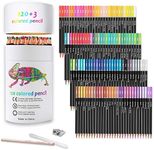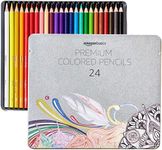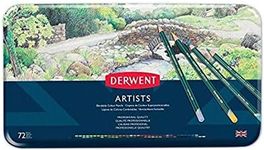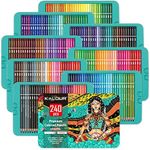Buying Guide for the Best Colored Pencils For Artists
Choosing the right colored pencils for artists can make a big difference in your creative process and the final look of your artwork. The best colored pencils for you will depend on your style, the techniques you use, and the results you want to achieve. Understanding the key features of colored pencils will help you select a set that matches your needs, whether you’re sketching, layering, blending, or working on detailed illustrations.Core Type (Wax-based vs. Oil-based)The core of a colored pencil is what gives it color and texture. Wax-based pencils are softer, blend easily, and are great for layering and shading, but they can sometimes produce a waxy buildup called 'bloom.' Oil-based pencils are firmer, hold a point longer, and are less prone to bloom, making them ideal for fine details and precision work. If you like smooth blending and soft textures, wax-based might suit you. If you prefer crisp lines and detailed work, oil-based could be a better fit.
LightfastnessLightfastness refers to how well the colors resist fading when exposed to light over time. This is important if you want your artwork to last and stay vibrant, especially if it will be displayed. Colored pencils are often rated for lightfastness, with higher ratings indicating better resistance to fading. If you’re creating art for display or sale, look for pencils with high lightfastness. For practice or sketching, this may be less critical.
Color RangeThe color range is the number of different colors available in a set. A larger range gives you more options for subtle shading and complex color mixing, while a smaller set can be more manageable and portable. If you enjoy experimenting with many shades and creating detailed, colorful pieces, a larger set may be best. If you prefer simplicity or travel with your supplies, a smaller set might be more practical.
Pencil HardnessPencil hardness affects how the pencil feels on paper and how much control you have. Softer pencils lay down color more easily and are good for blending, but they wear down faster. Harder pencils are better for fine lines and details but may not blend as smoothly. If you like bold, expressive strokes and blending, softer pencils are ideal. For technical drawing or fine details, harder pencils are preferable.
BlendabilityBlendability is how well the colors mix together on the paper. Some pencils are designed to blend smoothly, allowing you to create gradients and new colors. This is important for artists who like to layer and mix colors directly on their artwork. If blending is a key part of your technique, look for pencils known for their smooth blending abilities. If you prefer flat, solid colors, blendability may be less important.
Barrel Shape and ComfortThe shape and feel of the pencil barrel can affect your comfort during long drawing sessions. Barrels can be round, hexagonal, or triangular. Some artists find certain shapes easier to grip or less likely to roll off the table. If you draw for long periods, try different shapes to see which feels best in your hand and helps you maintain control.
ErasabilityErasability refers to how easily you can remove or lighten the pencil marks. Some colored pencils are easier to erase than others, which can be helpful for corrections or creating highlights. If you like to make changes as you work or use erasing as part of your technique, look for pencils with good erasability. If you work confidently and rarely erase, this may be less important.

















